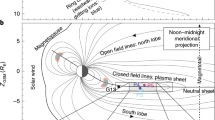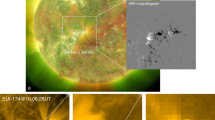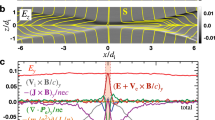Abstract
The most important process that allows solar-wind plasma to cross the magnetopause and enter Earth's magnetosphere is the merging between solar-wind and terrestrial magnetic fields of opposite sense—magnetic reconnection1. It is at present not known whether reconnection can happen in a continuous fashion or whether it is always intermittent. Solar flares2 and magnetospheric substorms3—two phenomena believed to be initiated by reconnection—are highly burst-like occurrences, raising the possibility that the reconnection process is intrinsically intermittent, storing and releasing magnetic energy in an explosive and uncontrolled manner. Here we show that reconnection at Earth's high-latitude magnetopause is driven directly by the solar wind, and can be continuous and even quasi-steady over an extended period of time. The dayside proton auroral spot in the ionosphere—the remote signature of high-latitude magnetopause reconnection4—is present continuously for many hours. We infer that reconnection is not intrinsically intermittent; its steadiness depends on the way that the process is driven.
This is a preview of subscription content, access via your institution
Access options
Subscribe to this journal
Receive 51 print issues and online access
$199.00 per year
only $3.90 per issue
Buy this article
- Purchase on Springer Link
- Instant access to full article PDF
Prices may be subject to local taxes which are calculated during checkout




Similar content being viewed by others
References
Cowley, S. W. H. in Magnetic Reconnection in Space and Laboratory Plasmas (ed. Hones, E. W.) 375–378 (Geophysics Monograph 30, American Geophysical Union, Washington DC, 1984)
Hudson, H. & Ryan, J. High-energy particles in solar flares. Annu. Rev. Astron. Astrophys. 33, 239–282 (1995)
Angelopoulos, V. et al. Statistical characteristics of bursty bulk flow events. J. Geophys. Res. 103, 21257–21280 (1994)
Phan, T. et al. Simultaneous Cluster and IMAGE observations of cusp reconnection and auroral proton spot for northward IMF. Geophys. Res. Lett. 30, doi:10.1029/2003GL016885 (2003)
Scholer, M. Magnetic flux transfer at the magnetopause based on single X line bursty reconnection. Geophys. Res. Lett. 15, 291–294 (1988)
Report of the NASA Science and Technology Definition Team for the Magnetospheric Multiscale (MMS) Mission (NASA/TM-2000–209883, Goddard Space Flight Center, Greenbelt, MD, 1999).
Phan, T. D. et al. Extended magnetic reconnection at the Earth's magnetopause from detection of bi-directional jets. Nature 404, 848–850 (2000)
Farrugia, C. J., Sandholt, P. E., Denig, W. F. & Torbert, R. B. Observation of a correspondence between poleward moving auroral forms and stepped cusp ion precipitation. J. Geophys. Res. 103, 9309–9315 (1998)
Lockwood, M. et al. Cusp ion steps, field-aligned currents and poleward moving auroral forms. J. Geophys. Res. 106, 29555–29569 (2001)
Lockwood, M., Davis, C. J., Onsager, T. G. & Scudder, J. D. Modelling signatures of pulsed magnetopause reconnection in cusp ion dispersion signatures seen at middle altitudes. Geophys. Res. Lett. 25, 591–594 (1998)
Sandholt, P. E. et al. Dynamic cusp aurora and associated pulsed reverse convection during northward interplanetary magnetic field. J. Geophys. Res. 105, 12869–12894 (2000)
Milan, S. E., Lester, M., Greenwald, R. A. & Sofko, G. The ionospheric signature of transient dayside reconnection and the associated pulsed convection return flow. Ann. Geophys. 17, 1166–1171 (1999)
Frey, H. U. et al. Proton aurora in the cusp. J. Geophys. Res. A 107, doi:10.1029/2001JA900161 (2002)
Fuselier, S. A. et al. Cusp aurora dependence on IMF Bz . J. Geophys. Res. A 107, doi:10.1029/2001JA900165 (2002)
Mende, S. B. et al. Far ultraviolet imaging from the IMAGE spacecraft: 3. Spectral imaging of Lyman alpha and OI 135.6 nm. Space Sci. Rev. 91, 287–318 (2000)
Newell, P. T., Meng, C.-I., Sibeck, D. G. & Lepping, R. Some low-altitude cusp dependencies on the interplanetary magnetic field. J. Geophys. Res. 94, 8921–8927 (1989)
Frey, H. U., Mende, S. B., Fuselier, S. A., Immel, T. J. & Ostgaard, N. Proton aurora in the cusp during southward IMF. J. Geophys. Res. A 108, doi:10.1029/2003JA009861 (2003)
Mende, S. B., Rairden, R. L., Lanzerotti, L. J. & Maclennan, C. G. Magnetic impulses and associated optical signatures in the dayside aurora. Geophys. Res. Lett. 17, 131–134 (1990)
Sandholt, P. E. IMF control of polar cusp and cleft auroras. Adv. Space Res. 8, 21–34 (1988)
Newell, P. T. Do the dayside cusps blink? Rev. Geophys. Suppl. 33, 665–668 (1995)
Lockwood, M. et al. IMF control of cusp proton emission intensity and dayside convection: Implications for component and anti-parallel reconnection. Ann. Geophys. 21, 955–982 (2003)
Cowley, S. W. H. & Owen, C. J. A simple illustrative model of open flux tube motion over the dayside magnetopause. Planet. Space Sci. 37, 1461–1475 (1989)
Acknowledgements
We are indebted to the IMAGE team and J. L. Burch for the design and successful operation of the IMAGE mission.
Author information
Authors and Affiliations
Corresponding author
Ethics declarations
Competing interests
The authors declare that they have no competing financial interests.
Rights and permissions
About this article
Cite this article
Frey, H., Phan, T., Fuselier, S. et al. Continuous magnetic reconnection at Earth's magnetopause. Nature 426, 533–537 (2003). https://doi.org/10.1038/nature02084
Received:
Accepted:
Issue Date:
DOI: https://doi.org/10.1038/nature02084
This article is cited by
-
Review of Mercury’s dynamic magnetosphere: Post-MESSENGER era and comparative magnetospheres
Science China Earth Sciences (2022)
-
The Location of Magnetic Reconnection at Earth’s Magnetopause
Space Science Reviews (2021)
-
Fluid and kinetic aspects of magnetic reconnection and some related magnetospheric phenomena
Reviews of Modern Plasma Physics (2020)
-
Dayside Aurora
Space Science Reviews (2019)
-
Muon Excess at Sea Level during the Progress of a Geomagnetic Storm and High-Speed Stream Impact Near the Time of Earth’s Heliospheric Sheet Crossing
Solar Physics (2017)
Comments
By submitting a comment you agree to abide by our Terms and Community Guidelines. If you find something abusive or that does not comply with our terms or guidelines please flag it as inappropriate.



